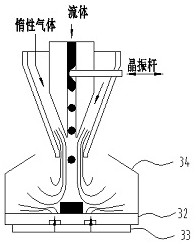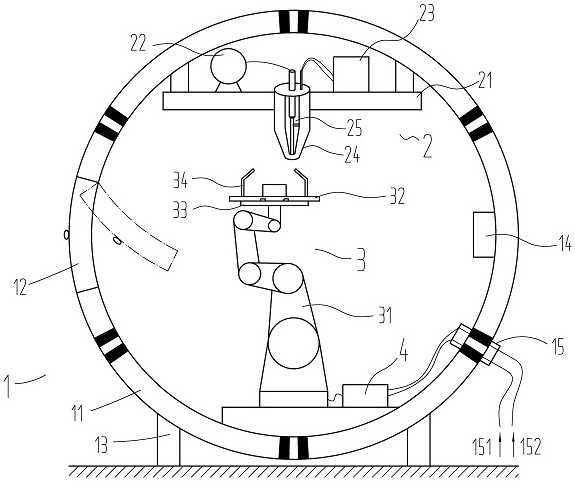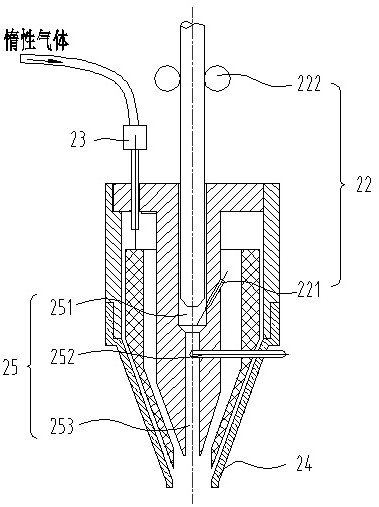A 3D printing system for materials in a microgravity environment
A 3D printing and microgravity technology, applied in the field of material 3D printing systems in a microgravity environment, can solve the problems of unfavorable 3D printing, easy spheroidization, etc., to improve 3D printing quality, reduce thermal stress, and achieve strong robustness. Effect
- Summary
- Abstract
- Description
- Claims
- Application Information
AI Technical Summary
Problems solved by technology
Method used
Image
Examples
Embodiment 1
[0032]This embodiment is applied to 3D printing of materials in a closed atmospheric environment, and the working environment is a manned spacecraft or a space station in a closed atmospheric environment. The manned spacecraft or space station in orbit is a closed cabin in an atmospheric environment. Under the action of microgravity, the fluid in the cabin is easy to form a spherical shape; in addition, the gas and other emissions generated during the material 3D printing process will seriously affect the artificial The quality of the atmospheric environment brings a series of safety hazards.
[0033] like figure 2 As shown in the figure, a material 3D printing system in a microgravity environment works in a sealed system that is insulated from the external environment and protected by an inert atmosphere of the internal environment, including a space capsule 1, a print head subsystem 2, a printing platform subsystem 3, and a control subsystem. 4. The space capsule 1 is used...
Embodiment 2
[0045] This embodiment is applied to 3D printing of materials in an open space environment. In a space base (such as a moon base) directly exposed to a vacuum environment, the 3D printing system is not only exposed to cosmic radiation, but also in an ultra-low temperature working environment. This places extremely high demands on the 3D printing system.
[0046] The material 3D printing system in the microgravity environment works in the airtight box of the space capsule 1 . The airtight box 11 is installed on the ground of the space base through the box fixing feet 13 , and is connected to the electrical interface equipped with the space base through the external interface 15 . The 3D printing system has a certain temperature and pressure inside during operation. The spherical shell can prevent the airtight box 11 from being deformed under the action of air pressure, and the double-layer thermal insulation structure can prevent the system heat loss caused by the vacuum heat r...
PUM
 Login to View More
Login to View More Abstract
Description
Claims
Application Information
 Login to View More
Login to View More - R&D
- Intellectual Property
- Life Sciences
- Materials
- Tech Scout
- Unparalleled Data Quality
- Higher Quality Content
- 60% Fewer Hallucinations
Browse by: Latest US Patents, China's latest patents, Technical Efficacy Thesaurus, Application Domain, Technology Topic, Popular Technical Reports.
© 2025 PatSnap. All rights reserved.Legal|Privacy policy|Modern Slavery Act Transparency Statement|Sitemap|About US| Contact US: help@patsnap.com



